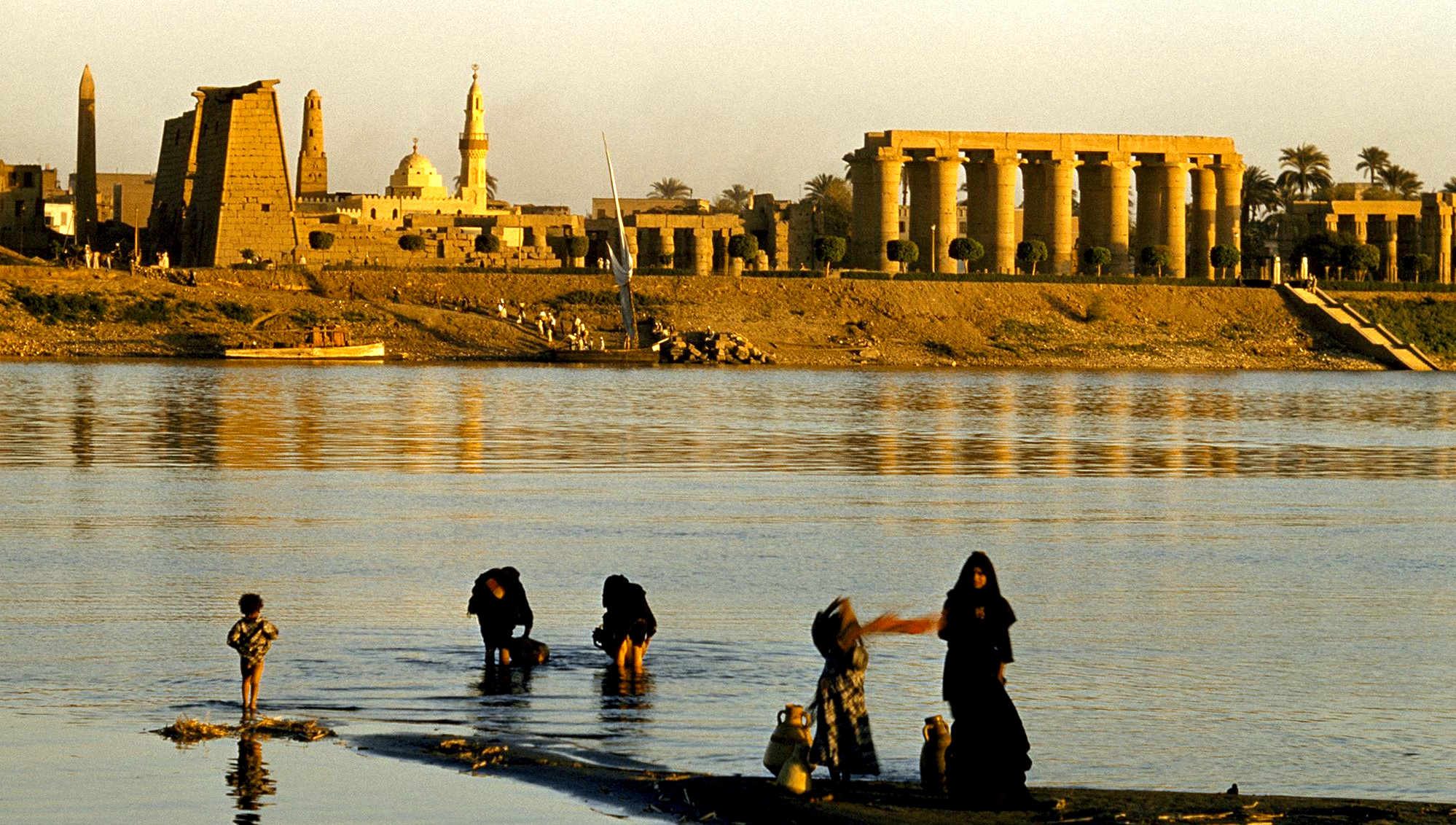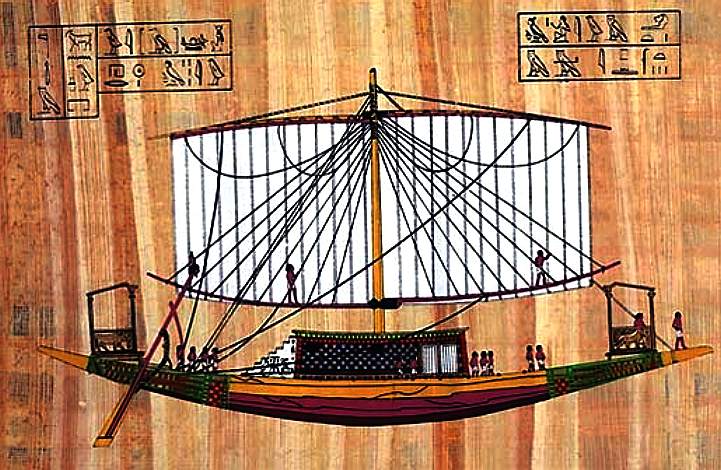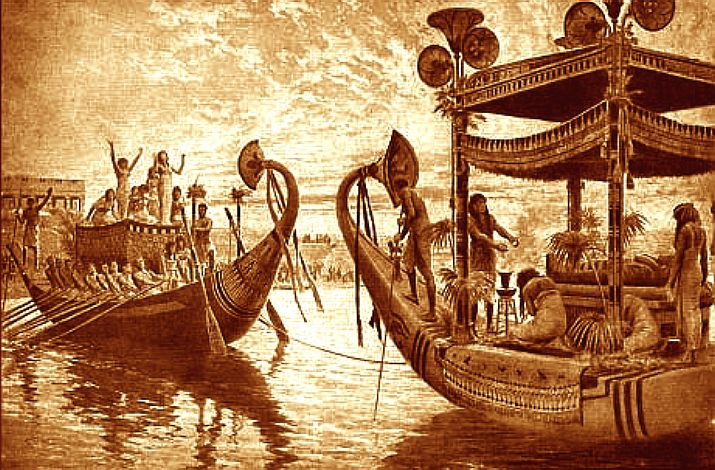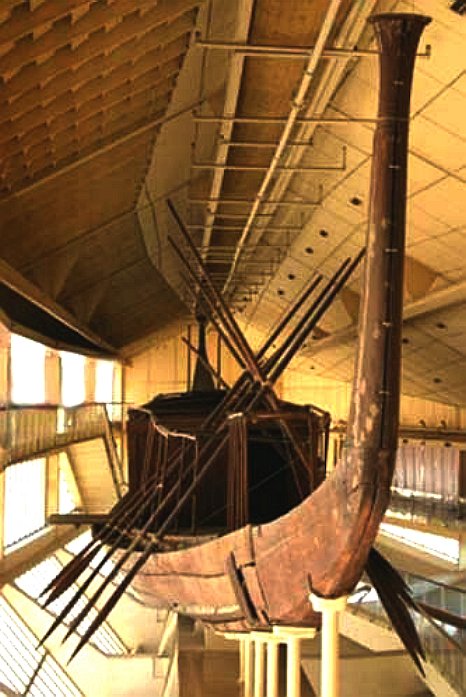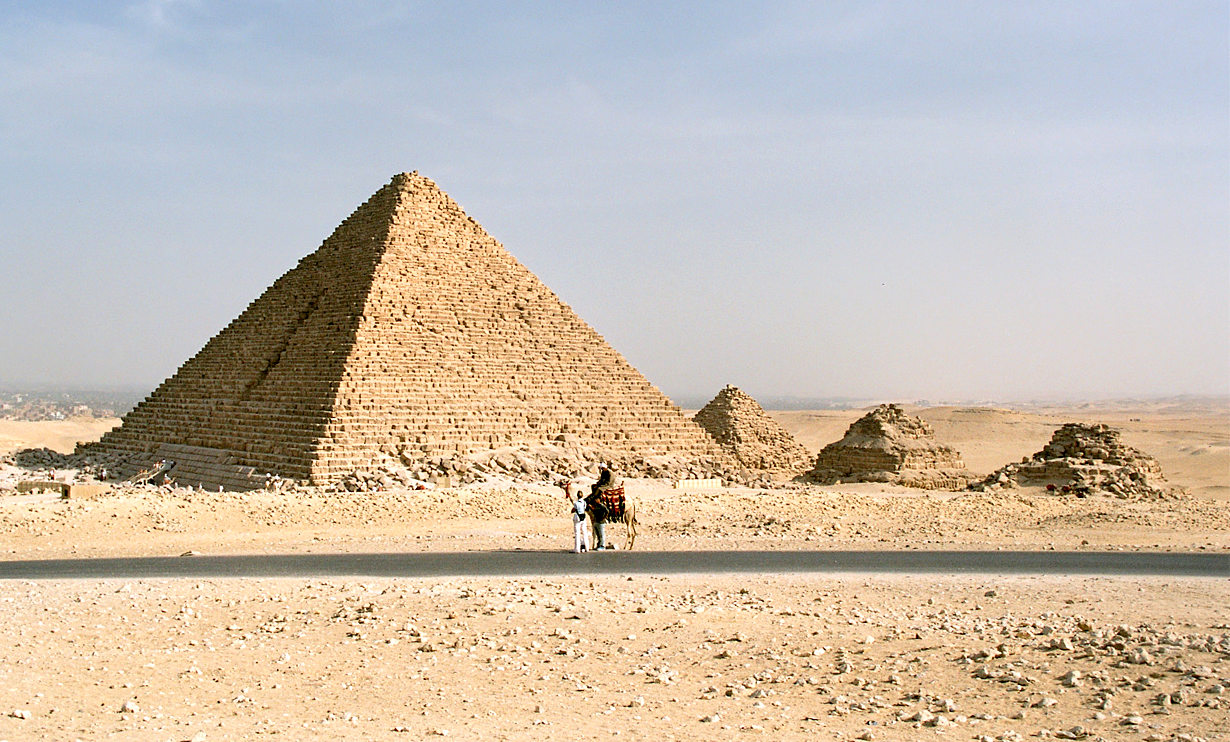
Menkaure's
Pyramid is the eighth tallest in Egypt, the smallest of the three main Pyramids of
Giza, located on the Giza Plateau in the southwestern outskirts of Cairo, Egypt. It is thought to have been built to serve as the tomb of the Fourth Dynasty Egyptian Pharaoh Menkaure.
The pyramid's date of construction is unknown, because Menkaure's reign has not been accurately defined, but it was probably completed in the 26th century BC. It is a few hundred meters southwest of its larger neighbors, the Pyramid of Khafre and the Great Pyramid of Khufu in the Giza necropolis.
CONSTRUCTION
Menkaure's pyramid had an original height of 65.5 meters (215 ft), and was the smallest of the three major pyramids at the Giza Necropolis. It now stands at 61 m (200 ft) tall with a base of 108.5 m (356 ft). Its angle of incline is approximately 51°20′25″. It was constructed of limestone and Aswan granite. The first sixteen courses of the exterior were made of the red granite. The upper portion was cased in the normal manner with Tura limestone. Part of the granite was left in the rough. Incomplete projects such as this pyramid help archaeologists understand the methods used to build pyramids and temples.
SARCOPHAGUS & COFFIN
Howard Vyse discovered on 28 July 1837, in the upper antechamber, the remains of a wooden anthropoid coffin inscribed with Menkaure's name and containing human bones. This is now considered to be a substitute coffin from the Saite period. Radiocarbon dating on the bones determined them to be less than 2,000 years old, suggesting either bungled handling of remains from another site, or access to the pyramid during Roman times. The lid from the anthropoid coffin mentioned above was successfully transported to England and may be seen today at the British Museum.
Deeper into the pyramid, Vyse came upon a basalt sarcophagus, described as beautiful black and rich in detail with a bold projecting cornice, which contained the bones of a young woman. Unfortunately, this sarcophagus now lies at the bottom of the Mediterranean Sea, having sunk on 13 October 1838, with the ship Beatrice, as she made her way between Malta and Cartagena, on the way to Great Britain. It was one of only a handful of Old Kingdom sarcophagi to survive into the modern period.
PYRAMID COMPLEX
Pyramid Temple
In the mortuary temple the foundations and the inner core were made of limestone. The floors were begun with granite and granite facings were added to some of the walls. The foundations of the valley temple were made of stone but both temples were finished with crude bricks. Reisner estimated that some of the blocks of local stone in the walls of the mortuary temple weighed as much as 220 tons, while the heaviest granite ashlars imported from Aswan weighed more than 30 tons. It is assumed that Menkaure's successor Shepseskaf completed the temple construction. An inscription in the mortuary temple that said he "made it (the temple) as his monument for his father, the king of upper and lower Egypt."
Subsequent architectural additions and two stelae from the Sixth Dynasty suggest that a cult for the Pharaoh was maintained (or was periodically renewed) for two centuries after his death.
Valley Temple
The Menkaure Valley Temple was excavated between 1908 and 1910 by American archaeologist George Andrew Reisner. He found a large number of statues mostly of Menkaure alone and as a member of a group. These were all carved in the naturalistic style of the old kingdom with a high degree of detail.
Queens' Pyramids
South of the pyramid of Menkaure are three smaller pyramids, designated G3-a, G3-b, and G3-c, each with accompanied by a temple and substructure. The easternmost is the largest and a true pyramid. Its casing is partly of granite, like the main pyramid, and is believed to have been completed due to the limestone pyramidion found close by. Neither of the other two progressed beyond the construction of the inner core.
Reisner speculated that the structures were likely tombs for the queens of Menkaure, and that the individuals buried there may have also been his half-sisters. The archaeologist Mark Lehner argues that Pyramid G3-a has a layout akin to a ka pyramid, which would have housed a statue of the king rather than a body. The fact that the structure once contained a pink granite sarcophagus, however, has led scholars to speculate that it may have been reused as a queen's burial tomb, or that it served as a chapel where the body of Menkaure was mummified.
DEMOLITION ATTEMPT
n AD 1196, Al-Aziz Uthman, Saladin's son and the Sultan of Egypt, attempted to demolish the pyramids, starting with that of Menkaure. Workmen recruited to demolish the pyramid stayed at their job for eight months, but found it almost as expensive to destroy as to build. They could only remove one or two stones each day. Some used wedges and levers to move the stones, while others used ropes to pull them down. When a stone fell, it would bury itself in the sand, requiring extraordinary efforts to free it. Wedges were used to split the stones into several pieces, and a cart was used to carry it to the foot of the escarpment, where it was left. Despite their efforts, workmen were only able to damage the pyramid to the extent of leaving a large vertical gash at its northern face.
Apart
from ruling their country, the
ancient Egyptians
had time to contemplate how they would cope in the afterlife
during the flooding of the Nile, when farm laborers could be
used to build, giving them a positive agenda. Each
successive ruler of the sandy kingdom, wished for more
comforts, and to outdo their forebears, in terms of how they
would be remembered.
Egypt was one of the richest and most powerful civilizations in the world
at that time. So could afford to convert their national
output, into something tangible, for their citizens to
marvel at. At the time they had few threats to national
security.
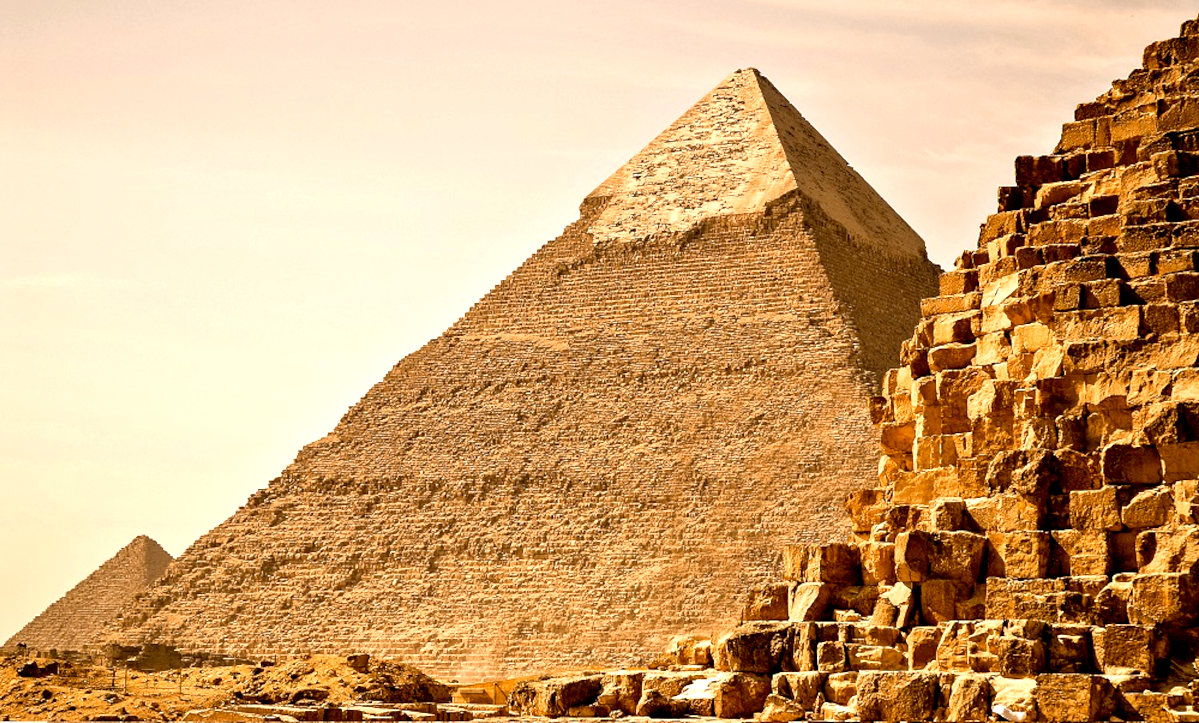
Generally,
the bigger the pyramid, the more important the Pharaoh. It's
a Freudian thing. This compendium is in order of height.
There are many very interesting pyramid designs that will be
covered in the general indexing, if they have unusual or
developmental features. Since, the art of pyramid
construction and development appears to have been an ongoing
thing, until it fizzled out as a result of resource scarcities, adventures of thieves, and land grants
to priests, as the last straw that broke the camel’s back.
Pyramids ceased to be economically viable, and a huge drain
on what we'd call the Gross National Product (GNP) today.
And as for climate
change, they are hardly a sustainable practice, in UN
SDG terms.
On
the basis that the
taller the pyramid, the higher the status of the
king or queen,
it might be argued that Khufu takes first prize, with Khafre
a close second. After that, nobody came close to 140 meters,
as the national goal to achieve a taller building than the
last ruler fell by the wayside.
Please
note, this is not a definitive table, but our own guide,
based on freely available information. Students of
archaeology and Egyptologists will draw their own
conclusions. Observations are most welcome, if we have
misquoted anything. We'd be pleased to make corrections as
applicable.

RULER
WITHOUT A PYRAMID - Tragically, queen Cleopatra poisoned herself
with an Egyptian cobra. Later her
mausoleum was washed into the sea by an earthquake and
tsunami in 365AD. Leaving little to visibly remind us of
the great Pharaoh.
The oldest known pyramid in Egypt was built around 2630 B.C. at Saqqara, for the third dynasty’s King Djoser. Known as the Step Pyramid, it began as a traditional mastaba but grew into something much more ambitious. The pyramid’s architect was Imhotep, a priest and healer who some 1,400 years later would be deified as the patron saint of scribes and physicians. Over the course of Djoser’s nearly 20-year reign, pyramid builders assembled six stepped layers of stone (as opposed to mud-brick, like most earlier tombs) that eventually reached a height of 204 feet (62 meters); it was the tallest building of its time. The Step Pyramid was surrounded by a complex of courtyards, temples and shrines where Djoser could enjoy his afterlife.
After Djoser, the stepped pyramid became the norm for royal burials, although none of those planned by his dynastic successors were completed (probably due to their relatively short reigns). The earliest tomb constructed as a “true” (smooth-sided, not stepped) pyramid was the Red Pyramid at Dahshur, one of three burial structures built for the first king of the fourth dynasty, Sneferu (2613-2589 B.C.) It was named for the color of the limestone blocks used to construct the pyramid’s core.
